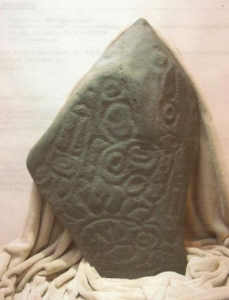A rare example of Aleutian petroglyphs has been donated to the University of Alaska Museum of the North’s archaeology collection and will be used in a variety of research projects to better understand the cultural roles of rock art in Unangam culture, according to collection manager Jim Whitney.
Under direct light, the stone doesn’t look unusual. But when lit from the side, images of whales, faces, sea lions, sea otters, birds, and eyes emerge. “It is an incredible, intricately carved piece,” Whitney said.
The seal stone was most likely collected on Shemya Island during WWII, a time when the area was transformed by a U.S. military looking to protect its frontier. Roads and landing strips were carved out of the earth, exposing items that were picked up by soldiers and taken home. The stone was discovered last year when the owners, who had purchased it in the 1950s and used it as a lawn ornament, wanted to sell it, hopefully to someone in Alaska.
Angela Linn, the museum’s ethnology & history collections manager, was one of the first people in Alaska to see photographs of the artifact forwarded from a dealer in Canada.
“I didn’t see anything that I recognized about it,” she said. “It was clearly a large rock with relief carving on the surface. The dealer said that the origin was listed as being from Shemya Island, so I sent it on to my contacts who work in the Aleutians. One of those was Allison McLain, who called me immediately. The rest is history, as they say.”
McLain is working on a survey of the stone’s designs, comparing them to others from the Aleutian Islands and the rest of Alaska. In a hundred years of archaeological work on the Aleutian Islands, only one other example of petroglyphs has been found. In 2002, biologists conducting a sea lion count on Agattu Island southwest of Shemya took some photos.
“Ten years later, this petroglyph shows up,” McLain said. “You can date the stone, but that won’t tell you anything except when the stone was formed. We’ve got 9000 years of evidence of human activity in that area, so we have no way to date when those carvings were made. I am looking at this stone as a piece of spiritual significance, an example of transformational spirituality.”
The seal stone was found on federal land, so in the summer of 2011, the owner donated it to the University of Alaska Museum of the North, the repository for most U.S Fish and Wildlife Service collections in Alaska. Museum staff will conduct several studies in addition to McLain’s survey of the design elements, including an analysis of the rock itself to see if it fits with the geology of Shemya and an oral history project documenting the stone and where it originated.
Whitney called the specimen a valuable addition to the collection. “These petroglyphs are a rare example of prehistoric art from the Aleutians and an intriguing mystery. The designs are physical representations of ideas and stories that were important enough to carve in stone.”
One benefit of preserving this piece in a museum is that it will be available for the public to see and for researchers to study. Whitney says the plan is to put the seal stone on display. “But first we need to finish the research before we can tell the story.”
The University of Alaska Museum of the North is a popular visitor attraction, a vital component of the university and the only research and teaching museum in Alaska. The museum’s collection – 1.4 million artifacts and specimens – represents millions of years of biological diversity and thousands of years of cultural traditions. The collections are organized into 10 disciplines (archaeology, birds, documentary film, earth sciences, ethnology, fine arts, fishes, insects, mammals, and plants) and serve as a resource for research on climate change, contaminants and other issues facing the circumpolar North.




